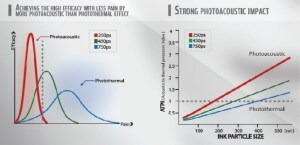PICOS LASER PIGMENT REMOVAL
Country of Origin: South Korea
PICOS is the latest aesthetic laser technology that releases peak power with the shortest laser pulse duration. It effectively breaks down the concentrated pigment patches underneath the skin surface, without damaging surrounding skin tissues. As laser penetrates the targeted spot precisely and effectively, the contact between skin and laser energy is minimized, thus limits melasma recurrence.
Features of the machine:
- Shortest Pulse Duration: Being 1000 times faster than traditional nanosecond laser, peak energy is released in a pico-second (10−12 s). PICOS breaks pigment patches into shatter fragments within an ultra-short pulse duration, that will be easily absorbed by macrophage. Effectiveness also remains high for deep pigments (e.g. melasma and birthmark).
Pigments after nano-second laser irradiation
Pigments after pico-second laser irradiation


- Dual Wavelength Laser: The two wavelengths (1064nm/532nm) can penetrate into layers of skin and tackle both epidermal and dermal pigments.
- High Peak Energy: Thermal Relaxation Time(TRT) of pigment is lower than 10 nanoseconds. Comparing with the nanosecond mode, the pulse duration of PICOS(150ps) is 100 times shorter than general Q-switched Nd:YAGlaser(10ns). With the same energy density, PICOS makes a more effective treatment due to its high peak energy and minimum level of surrounding skin damage.

Photoacoustic Mechanism: Unlike traditional laser, PICOS uses photoacoustic mechanism to eliminate pigments. The use of focusing lens allows energy to concentrate on a tiny spot, which effectively breaks down the concentrated melanin without damaging surrounding skin tissues. It also minimizes discomfort during treatment, limits melasma recurrence, and speed up recovery.
Efficacy:
- Epidermal Pigments: Solar lentigo, Freckles, Post-Inflammatory Hyperpigmentation, Seborrheic Keratosis, Café au lait spots, etc.
- Dermal Pigments: Nevus of Ota, Nevus of Ito, Blue nevus, Becker’s nevus, Melasma, Acquired Dermal Melanocytosis, etc.
